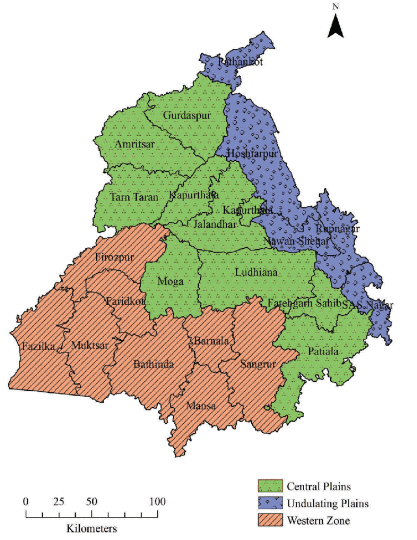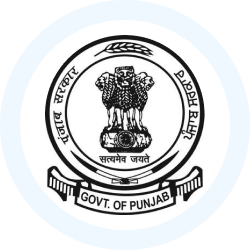Physiography and Climate of Punjab | Punjab State (PPSC) PSC: Preparation - PPSC PCS (Punjab) PDF Download
| Table of contents |

|
| Introduction |

|
| Geographical Location of Punjab |

|
| Geographical Structure of Punjab |

|
| Climate of Punjab |

|
Introduction
- The Punjab area is located in the northwestern part of the Indian subcontinent, and it holds great geographical and historical importance.
- This region features low hills and fertile flood plains, known as alluvial plains.
- The climate of Punjab can be described as having extreme heat in the summer and extreme cold in the winter.
- Punjab experiences moderate rainfall, mainly during the monsoon season and due to Western disturbances.
Geographical Location of Punjab
- Punjab is located in the sub-tropical region of the Indian subcontinent, in the northwestern part of India. The state is positioned between 29°30' to 32°32' North latitude and 73°55' to 76°50' East longitude. Covering an area of 50,362 square kilometers, Punjab accounts for 1.54% of India's total geographical area, making it the 20th largest state in the country.
- The distance from north to south is approximately 335 kilometers, while the distance from east to west is about 300 kilometers. Punjab shares a 553-kilometer international border with Pakistan to the west and is bordered by the Indian states of Jammu and Kashmir to the north, Himachal Pradesh to the northeast, and Haryana and Rajasthan to the south.
- The shape of Punjab is roughly triangular, with Pathankot district at the northern tip of the triangle and Fazilka and Patiala at the bottom left and right corners, respectively.
Geographical Structure of Punjab
Punjab is primarily situated on the flat alluvial flood plains of the Sutlej, Indus, and Yamuna river basins. The eastern, northwestern, and northeastern regions are surrounded by low hills, while the southwestern region is bordered by sandy areas. Punjab can be divided into the following landforms:

(i) The Shiwalik Hills
Punjab is bordered by the Shiwalik hills to the northwest, north, and northeast. This tract of Shiwalik hills is 5 to 12 km wide and runs along the northeastern part of the state. The hills generally range from 400 m to 700 m above sea level.
- The Shiwalik hills are covered with bush and small vegetation.
- The area between the Shiwalik hills and the plains is characterized by a discontinuous series of longitudinal valleys known as duns.
- The Shiwalik hills cover the easternmost areas of five districts: Pathankot, Gurdaspur, Hoshiarpur, Rupnagar, and Nawanshahr.
- Chandigarh is situated near the foothills of the Shiwalik range in North-West India.
(ii) The Foothill Zone or Kandi Region
- At the base of the Shiwalik hills lies a 10 to 15 km wide dissected undulating zone known as the Kandi tract. This region is situated between 300 m and 400 m above sea level and is characterized by rocky soil.
- The Kandi region is neither entirely mountainous nor plain and faces a shortage of drinking water. It is covered with thorny bushes and dry forests.
- Seasonal streams, locally called Chos, flow through this region, causing significant soil erosion, gully erosion, and destruction of farmland.
- The Kandi region emerged due to deforestation in the Shiwalik hills to meet the timber needs for construction.
- The southern parts of Pathankot, Hoshiarpur, Gurdaspur, Nawanshahr, and the entire Rupnagar district lie in this region.
- The foothill zone in the Anandpur Sahib block of Rupnagar is called Changar, while the upland plain west of the Shiwalik in Rupnagar district, south of the Sirsa River, is known as Ghar.
(iii) The Flood Plains or Alluvial Plains
- The flood plains of Punjab are part of the Indo-Gangetic plain formed by soil deposited by the Himalayan rivers. These plains are situated between 180 m and 300 m above sea level.
- The flood plains on the eastern side of the rivers are relatively extensive and wide, with the area south of the river being much wider than to the north. This is due to the westward shift of the river's course.
Flood Plains of Punjab
Punjab, known as the "Granary of India," is characterized by its fertile flood plains, which are vital for agriculture. These flood plains are formed by the alluvial deposits of the rivers Ravi, Beas, and Sutlej, along with their tributaries. The state is divided into three main regions based on these flood plains: Malwa, Doab, and Majha.
Malwa Region:
- Location: Between the Sutlej River in the north and the Ghaggar River in the south.
- Districts: Barnala, Bathinda, Fatehgarh Sahib, Faridkot, Fazilka, Firozpur, Ludhiana, Mansa, Moga, Mohali, Muktsar, Patiala, Ropar, Sangrur.
- Characteristics: Covers the largest part of Punjab with the most fertile land, suitable for various agricultural activities.
Doab Region (Bist Doab):
- Meaning: 'Doab' means 'land between two rivers.'
- Location: Between the Beas River in the northwest and the Sutlej River in the south.
- Districts: Hoshiarpur, Kapurthala, Jalandhar, Nawanshahr.
- Characteristics: Known for its fertility and was a center for the Green Revolution in India, leading to increased agricultural productivity.
Majha Region (Upper Bari Doab):
- Location: Between the Beas River in the east and the Ravi River in the west.
- Districts: Amritsar, Gurdaspur, Tarn Taran Sahib, Pathankot.
- Characteristics: Often referred to as the "Heart of Punjab," this region is known for its rich agricultural land and cultural significance.
(iv) Sandy Plains
- Composition: Made of old alluvium (silt) deposited by rivers descending from the Himalayas.
- Surface Cover: Known as Tibbas, this surface cover results from alluviation by the Sutlej and Ghaggar rivers.
- Western Part: Referred to as Ather.
- Southern Area: Part of the Thar Desert, with a dry climate, including the Southern Bari and Rachna Doab regions. These areas are known as Ganji Bar (dry wastelands) and Neeli Bar.
- Districts: Bathinda, Faridkot, Firozpur, Mansa, Muktsar, Sangrur, Patiala.
Climate of Punjab
Punjab experiences both extremely hot and extremely cold weather. Areas close to the Shiwaliks receive heavy rainfall, while Southern Punjab, which is farther from the hills, has low rainfall and high temperatures. On average, rainfall ranges from 960 mm in the sub-mountainous regions to 460 mm in the sandy plains.
Climatic Seasons of the State
Punjab has a continental, semi-arid to sub-humid climate, and its weather is marked by distinct seasons. The difference between summer and winter is very clear, and these two main seasons correspond to the two primary crop seasons: kharif and rabi.
The climatic seasons in Punjab are as follows:
Summer/Hot and Dry Season:
- This season begins in mid-April and lasts until the end of June.
- Summer in Punjab is characterised by intense heat, with bright sunshine, minimal rainfall, low humidity, and frequent dust storms.
- June is the hottest month, with an average maximum temperature of 41°C, although elevated areas may be 2 to 5°C cooler.
- During May and June, a hot and dry westerly wind known as Loo blows in the afternoon.
- The heat is more intense in West and South-West Punjab compared to East and North-East Punjab.
Rainy Season:
- The rainy season starts in early July and continues until the end of September.
- This season is marked by the arrival of the monsoon, triggered by the formation of a low-pressure area in Punjab by the end of June.
- Punjab receives the South-West monsoon earlier than the rest of the country.
- During this period, humidity and temperatures remain high.
- Punjab’s average annual rainfall is just over 60 cm, with significant regional variations.
- Rainfall ranges from 150 cm in the Shivalik hills in the North and North-East to less than 25 cm in the West and South-West.
- Approximately 70 to 80% of the total rainfall occurs during the South-West monsoon, which has two branches: the Arabian Sea branch and the Bay of Bengal branch.
- Both branches contribute moderate rainfall to Punjab.
- The monsoon is crucial for Punjab’s economy, marking the beginning of the agricultural year with the kharif crop.
- In winter, Punjab also receives rainfall through Western disturbances.
Autumn/Post-Monsoon Season:
- The monsoon typically retreats by mid-September, leading to a gradual change in weather that continues until the end of November. October and November are transitional months between the rainy and winter seasons, characterised by generally dry and clear weather. Daytime temperatures remain high, but nights become pleasant during this season.
- The post-monsoon but pre-winter period features comfortable temperatures ranging from 20°C to 25°C. Throughout the year, there is a wide variation in summer and winter temperatures, as well as in day and night temperatures.
Winter/Cold Season:
- The winter or cold season lasts from early December to the end of February. During this time, the region experiences rainfall due to cyclones coming from the west. Frost is also common in this season. The mean temperature during the cold season remains below 20°C, with January being the coldest month, averaging around 10°C.
- The winter rainfall, brought by the western cyclones, accounts for 15% of the total rainfall. Although this rainfall is minimal, it is highly beneficial for rabi crops. The northwestern parts of the Punjab region receive more of this winter rainfall compared to the eastern parts.
Spring Season:
- The spring season marks the transition from cold weather to the gradual onset of summer.
- It begins in March and continues until mid-April.
- During this period, there may be showers accompanied by hailstorms, which can potentially damage growing crops.
- The winds during spring become warm and dry, and the frequency of western disturbances also starts to decrease.
|
23 videos|50 docs|47 tests
|




















